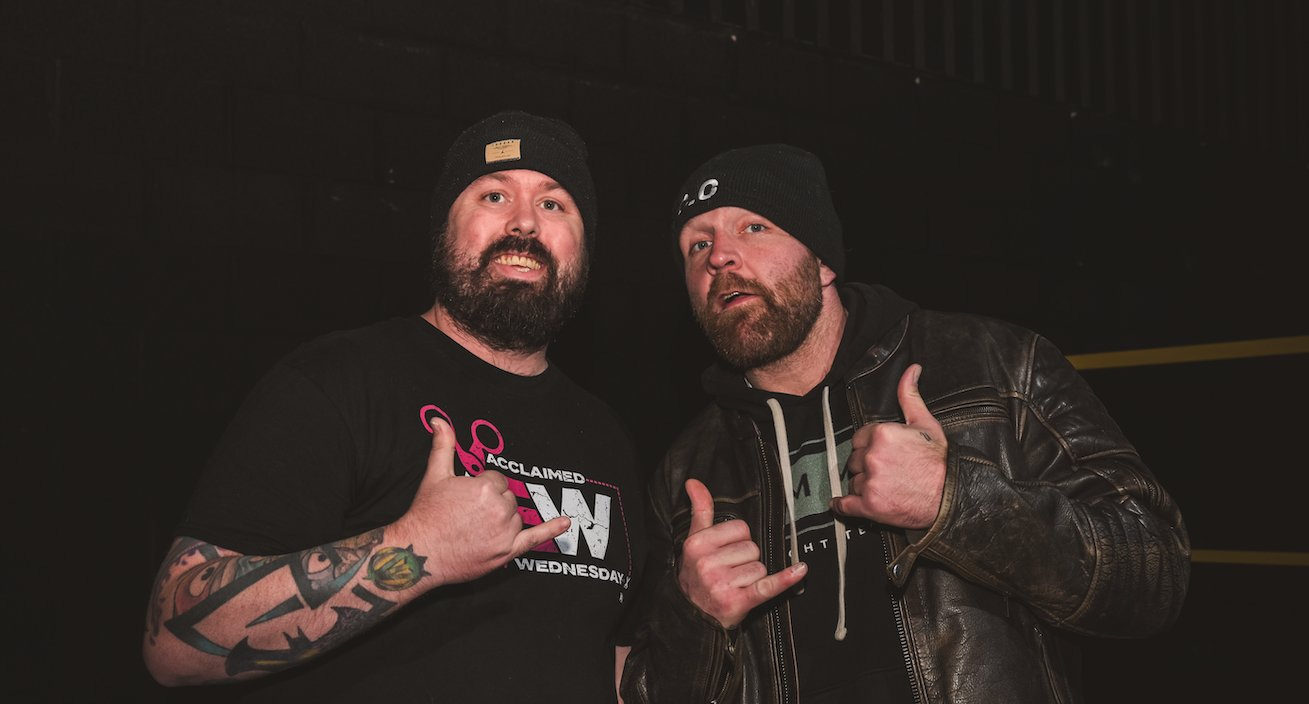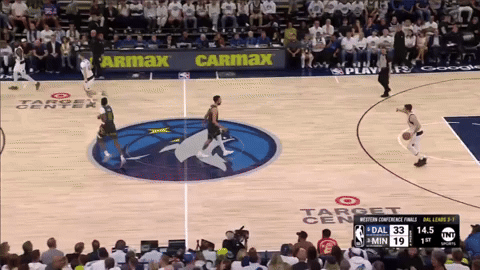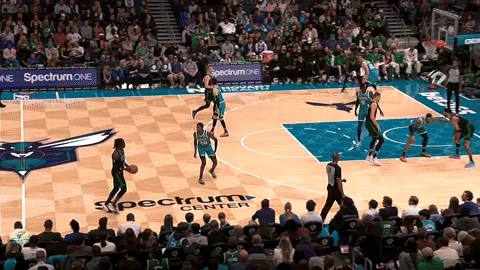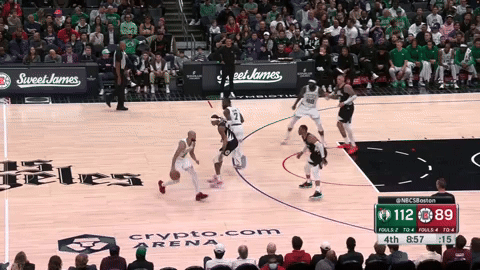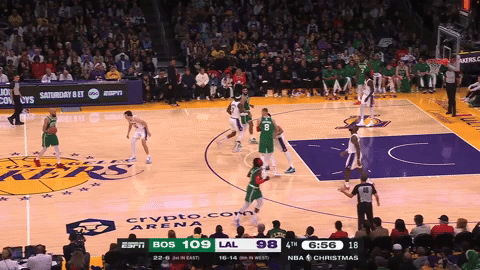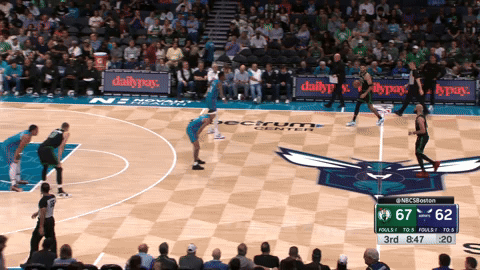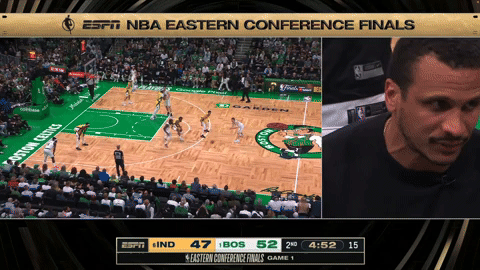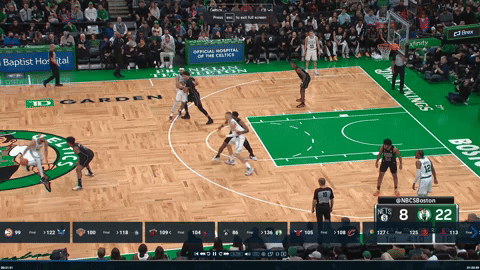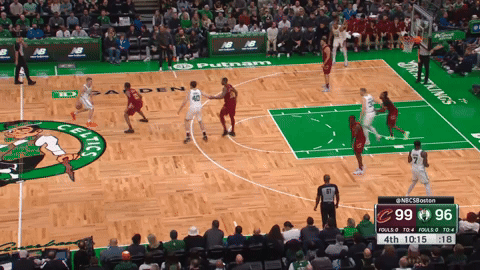Mavericks Melee: Celtics' Championship Crusade
A Dallas Mavericks and NBA Finals scouting report.
As I sit here at 8 am on a Friday, contemplating the realization that Luka Doncic and Kyrie Irving stand in Boston’s way of a championship, I have two analogies running through my head.
The first is how WWE ran with ‘The Final Boss’ narrative leading up to WrestleMania, where The Rock returned from his sabbatical to insert himself into the Main Event Picture. The second is Jay-Z’s collaborative album with Linkin’ Park back in 2004, fittingly named Collison Course.
To me, both these analogies make sense. Kyrie Irving has been on a sabbatical from this stage. Since leaving the Cleveland Cavaliers, he’s had a Hollywood-worthy decline, leading to a wild glow-up that makes him the type of protagonist casual viewers love to eat up.
While Collison Course speaks to a team-up of Titans. At the time of release, Linkin’ Park was the biggest Nu Metal band on Earth (Sorry, Limp Bizkit, you still have a place in my heart.) Jay-Z was the biggest Hip-Hop star. That mash-up album still has its place on my playlist 20 years later. It was fun. It was different. It was two styles that people thought couldn’t mesh but found a way of co-existing in one space to become a dynamic pairing.
I thoroughly enjoyed this year’s WrestleMania. I’m a big wrestling fan. WWE & AEW are my jams.
And I played that Collision Course album until my CD was worn and battered. Now, certain songs live on several of my playlists. I am a Nu Metal kid at heart. An Elder-Emo, if you will.
But at the forefront of everything is basketball.
I’ve loved basketball since I was 7 years old.
I remember the last time the Celtics won a championship. I remember staying up late as a 21-year-old with no commitments. I remember being on my own at a stupid time in the morning, celebrating a win that no one around me would care about, celebrating the achievements of a team thousands of miles away. Things will be different next time, I hope.
Before discussing championship celebrations or parades, the Celtics have one final boss to overcome. And if computer games have taught us anything, it’s that you can never underestimate the resilience and un-relenting offense that awaits in that final battle. Fortunately, as I’ve done in every series leading up to this point, I will try and paint a picture of what the Celtics are up against.
Dallas: By the numbers
The Dallas Mavericks ended the regular season ranked 8th in the league for offensive rating, averaging 117 points per 100 possessions. They are 6th in the postseason, dropping an average of 115.2 points per 100. However, there’s somewhat of a different story on the defensive end.
In the regular season, the Mavericks were 18th in the league for defensive rating, allowing 114.6 points per 100. In the playoffs, they’re 7th, with 111.1 per 100. PJ Washington’s addition has helped bring balance to their defensive system. And Maxi Kleber’s return from injury will also pay dividends.
The Mavericks' defense is better than many give it credit for. However, they’ll be tested when facing Boston. Their ability to guard 1-through-5, when everyone can put the rock on the floor, score off the dribble or off the catch, and create for others, will be the biggest test of Dallas’ defensive credentials. If Kristaps Porzingis is back in the Celtics rotation, dealing with Boston’s spacing will also be another significant test.
One thing the Mavericks can’t do, is allow themselves to be drawn into a shoot-out against the Celtics. Becuase Boston has too many weapons at their disposal.
The Celtics aren’t a team you want to get into a shootout with — they’re just as talented on offense but have a far more dominant rearguard, which should prove to be the difference maker.
I wrote this quote when breaking down the Eastern Conference Finals series against the Indiana Pacers. It remains true heading into the NBA Finals. The notable difference is the presence of Luka Doncic and Kyrie Irving — which we will get into later.
Let’s start peeling off some additional layers. All data, unless stated otherwise, is courtesy of Cleaning The Glass. I have stuck with regular-season data because it has a bigger sample size and paints a clearer picture.
Offensive Shot location frequency
This is where Dallas’ offense is coming from and how frequently they look to attack those spots. The higher the league ranking, the more frequently the Mavericks are attacking those spots vs. other teams in the league.
Around the rim - 28.5%, 29th in the league
Mid-Range - 30.6%, 18th in the league
Short mid-range - 20.5%, 25th in the league
Long mid-range, 10%, 8th in the league
3-Point range - 41%, 2nd in the league
Non-Corner 3’s - 28.9%, 7th in the league
Corner 3 - 12%, 1st in the league
Offensive Shot location accuracy
This is how accurately a team is shooting from each location on the court - the higher the league ranking, the better the Mavericks are at scoring in those areas.
Around the rim - 71.2%, 2nd in the league
Mid-Range - 45.3%, 9th in the league
Short mid-range - 43.6%, 11th in the league
Long mid-range, 46.1%, 9th in the league
3-Point range - 37.6%, 11th in the league
Non-Corner 3’s - 38.1%, 6th in the league
Corner 3 - 36.5%, 28th in the league
Putting that into context
The Mavericks are a perimeter-based team. They like to space the floor and take a high volume of shots from three-point range. They take and make a considerable amount of perimeter jumpers. The gravity and creation of Irving and Doncic creates open shooting opportunities elsewhere on the court. There’s a reason why they ranked 1st in corner threes throughout the regular season. Jason Kidd has them playing a spray offense while making reads out of doubles.
Dallas also projects to be a threat when attacking close-outs. They’re a top-10 team in long mid-range frequency and conversion. That becomes more prevalent in the postseason when the big is likely to be playing in drop rather than at the level of the screen. The Mavericks being so good at attacking close-outs forces a team to pick their position. You either run them off the line and live with the results in the mid-range, or you adjust your coverage and risk getting beaten to the rim.
Against the Pacers, the Celtics were content with allowing mid-range offense. They made a legitimate effort to minimize open threes and take away the rim. I would expect we see the same strategy against the Mavericks.
Joe Mazzulla won’t want Doncic or Irving getting downhill at will. As such, keeping a rim protector in drop may be the best option, as long as the gap help consistently pressures the ball-handler in space.
During the postseason, the Mavericks’ biggest weapon has been that corner three. They rank 1st in the playoffs for frequency and are hitting the shot at a 40% clip. When a team is hitting the corner shot so consistently, it puts pressure on the help defense. Because if you send help out of the corner, you’re getting punished when the rock is kicked out. Boston consistently uses corner help to provide rim protection from a roamer — usually Tatum.
Mazzulla may have to rethink that defensive principle if he doesn’t want to feed the Mavericks a steady diet of corner threes.
Defensive shot location frequency
This is where opposing teams look to generate their offense against the Mavericks’ defense - the lower the league ranking, the more frequently teams attack those spots.
Around the rim - 31.6%, 11th in the league
Mid-range - 32.1%, 24th in the league
Short mid-rage - 22.7%, 18th in the league
Long mid-range - 32.1%, 19th in the league
3-Point range - 36.4%, 14th in the league
Non-Corner 3’s - 25.4%, 7th in the league
Corner 3 - 10.8%, 24th in the league
Defensive shot location success rate
This is where opposing teams find success on offense - the lower the league ranking, the more successful teams are from those spots.
Around the rim - 67.6%, 22nd in the league
Mid-range - 43.1%, 14th in the league
Short mid-rage - 43.9%, 16th in the league
Long mid-range - 41.1%, 10th in the league
3-Point range - 37.5%, 19th in the league
Non-Corner 3’s - 37.2%, 22nd in the league
Corner 3 - 38.1%, 13th in the league
Putting that into context
Dallas’ limited three-point defense will be a real issue for them. The Celtics are first in the postseason for three-point frequency and first for non-corner three-point frequency. 43.7% of their total offense is coming from deep. In terms of conversion, Boston is seventh in the postseason for three-point percentage, hitting 37.2% and third in non-corner three percentage, hitting 38.6%.
The Celtics are also second in the playoffs for finishing at the rim, although they’re 15th for frequency. Nevertheless, the Celtics’ ability to force defensive collapses before finding open shooters on the perimeter will be a legitimate issue for Dallas. They can’t overreact to the Celtics' gravity; otherwise, they will find themselves chasing shadows and defending in space, which is the worst place they want to be.
Another issue for the Mavericks will be their willingness to live with mid-range jumpers. The Celtics have embraced the middle of the court this season, with Brown and Tatum both thriving as mid-range assassins. The Celtics are shooting 43% on middies during the playoffs. If the Mavericks are going to let the Celtics shoot those shots, they will quickly find themselves scrambling for answers. Such is the beauty of being littered with three-level scorers in the rotation.
I will be interested to see how sturdy the Mavericks rim defense is, though. Both in terms of deterring attempts and impacting them when they occur. Boston will look to get downhill whenever possible. They’ve also started adding more corner drives into their offense, even getting Tatum some looks in those spots during the final stages of the ECF.
Overall, Dallas’ defense will be the primary swing factor in how long this series goes and who takes control. If the Mavericks can shore up their perimeter defense and pressure the mid-range without giving up coverage elsewhere, this will be a tough series. If they find themselves getting cooked on side-to-side actions around the horn, it’s going to be a tough run for them.
When I started this newsletter earlier this season, I set the lofty goal of hitting 1000 subscribers before the end of the postseason. While close, there’s still some room to go. If you enjoy my work, please show some love by hitting subscribe!
Setting the Stage for the Celtics: The path of least resistance
Offensive Shot location frequency
This is where Boston’s offense is coming from and how frequently they look to attack those spots. The higher the league ranking, the more frequently the Celtics are attacking those spots vs. other teams in the league.
Around the rim - 29.1%, 26th in the league
Mid-Range - 27.1%, 29th in the league
Short mid-range - 18%, 29th in the league
Long mid-range - 9.1%, 14th in the league
3-Point range - 43.7%, 1st in the league
Non-corner 3’s - 33.8%, 1st in the league
Corner 3 - 9.9%, 12th in the league
Offensive Shot location accuracy
This is how accurately a team is shooting from each location on the court - the higher the league ranking, the better the Celtics are at scoring in those areas.
Around the rim - 70.5%, 4th in the league
Mid-Range - 44.6%, 12th in the league
Short mid-range - 44.7%, 13th in the league
Long mid-range, 44.2%, 9th in the league
3-Point range - 39.3%, 2nd in the league
Non-Corner 3’s - 38.1%, 8th in the league
Corner 3 - 43.6%, 1st in the league
Stampede cuts
If the Celtics are going to draw a crowd on the perimeter, they should look to punish the additional space with forceful cuts toward the rim. Dallas has been using Irving in a similar spot and did so last night to end the first quarter of Game 4.
If the Celtics are going to lean into attacking via stampede cuts, Brown is the most likely candidate due to his explosiveness and how much he seems to enjoy bully-driving his way to the rim.
I chose the above play against the Charlotte Hornets because it’s a good example of how you can generate rim pressure without relying on perimeter-based actions. We all know the Celtics will draw a crowd when running PnR sets with Tatum or Brown as the ball-handler. But what happens when the defense is set in the half-court and both forwards are operating off the ball?
In this clip, the Celtics get Tatum out of the dunker spot and onto the perimeter via a Zipper Cut. On the weak side of the floor, Sam Hauser sets a wide pin-down for Brown, who curls over the screen and stampede cuts after receiving the pass. Notice how Hauser lifts out of the corner as the defense collapses to offer a passing outlet for an easy three.
By leaning into stampede actions, the Celtics will be testing the Mavericks’ ability to protect the rim while also testing their reactivity on the perimeter. It’s a good way of punishing the defense for trying to load up on the ball-handler while also finding easy scoring opportunities that come with the chance of drawing a foul.
If the defense adjusts and looks to kill the drive, both Brown and Tatum are adept at countering by pulling up in the mid-range. As we’ve seen, the Mavericks are willing to live with that shot, and don’t have a good track record of impacting them at a consistent rate.
Horns sets
Another way to leverage the Celtics' three-level scoring is to lean into a series they’ve run all year: Horns. Joe Mazzulla has a deep playbook out of this alignment, all of which can lead to scoring opportunities across the floor. The most prevalent option is chin, which has been a staple all season but has rarely been leaned on during the postseason.
A chin action is part of its own “chin” series. The clip above is the basic chin set. It starts in a Horns alignment. The ball-handler feeds one of the players on the elbow before coming off a screen from the other player and cutting on the non-ball side of the floor. That action usually opens up an easy lane to the rim.
Of course, if the defense reacts quickly, the cutter can turn into a short-roll creator in seconds, using the gravity of his cut to hit an open shooter in the corner.
If the cutter isn’t in a position to receive the pass due to the defense reading the action, the screener can flow into a veer action to open up a chin veer which gives the ball-handler an opportunity to get down hill as the defense recovers from initial rotation on the entry cut.
Again, the point of leaning into this action would be to generate scoring opportunities at all three levels. The cutter can counter the defense with a mid-range pull-up, a kick-out to the three-point line, an escape dribble, or by veer-stepping in front of the defender to seal them off and potentially draw a foul.
Another action that can be run out of Boston’s Horns series is UCLA. It’s very similar to a chin action, however, the cut occurs on the ball-side of the screener, rather than the non-ball side.
The potential outcomes from this play are the same as running Chin. The primary difference is the pressure it puts on the cutter's defender if they’ve been sold on the screen and have attempted to go under or to try and cancel the screen, which, as you can see in the clip above, can generate some additional space.
One variance with the UCLA action that Boston has liked to deploy at times this season is having the UCLA screener pop into space around the slot. The cut then acts as the decoy, while the real action is getting a shooter popping into space while the defense reacts to the threat of the cut.
There are other Horns actions that Mazzulla could go to, but that would need another article entirely. If you would like to see that, then let me know in the comments and I can get something done before the start of the NBA Finals.
Stack actions: A.K.A The Spain Pick-and-Roll
I’ll keep this section short.
Last season, the stack was a primary part of Mazzulla’s offensive playbook. This season, it’s been less prevalent, and when the Celtics have gone to it, it’s been designed as window dressing before the real action took place. However, given the Mavericks’ desire to defend the perimeter, leaning into some stack actions could be a good ploy to generate some easy looks.
Hauser is usually the beneficiary of these actions. It makes sense given his elite catch-and-shoot threat. However, Payton Pritchard, Brown, Tatum and Porzingis all make sense in this spot. Especially if you feel like the popper (Hauser in the clip above) may need to take a 1 or 2 dribble pull-up to attack a closeout.
Still, if you’re looking to create space on the perimeter and lean into your identity as a fearsome three-point team, running stack against a defense that struggles to impact the perimeter could be a wise bet.
Special Offer!
To celebrate the Celtics making the NBA Finals, I’m running a limited-time special offer on annual subscriptions. Get 40% off your first year, and get full access to:
3-5 additional articles per week
X’s and O’s breakdowns
Cross-over discussions with other writers from around the league
Analysis posts
Thoughts on news, rumors, and trending topics
Occasional subscriber-only podcasts
Subscriber-only chats
For a yearly price equivalent to a few cups of coffee, you will be directly supporting the growth of this newsletter. Join the growing number of readers who pay for full access to the Celtics Chronicle by redeeming your special offer today!
Celtics vs. Mavericks: The Matchups
Matchups are always fluid. Mazzulla has shown a willingness to be experimental throughout games and the lifespan of a series. If I had to hazard a guess, I would expect the opening matchups to be something like:
Doncic - Brown
Irving - Holiday
Jones Jr. - White
P.J. Washington - Tatum
Gafford - Porzingis
My thinking is that Brown will want the task of guarding Doncic to begin the series. He’s been vocal about guarding the opposing team’s best player and has proven himself to be an elite on-ball defender. Brown has the athleticism, size and physical strength to hang with Doncic over screens or in space. Brown also has enough body control to try to keep pace with Doncic when he decels around the rim or off drives.
Having Tatum on Washington allows him to switch when needed or rotate over as a helper — if the Celtics decide to stick with that system in light of Dallas’ threat from the corners.
I have Porzingis starting on Gafford, but I have some questions there…
Three questions I have heading into the game
Will Porzingis start or come off the bench?
Porzingis has missed over a month of basketball. Judging by the available reporting and his own comments, we’re likely to see him back in the rotation for the NBA Finals. However, there’s a chance he will need to work himself back into game shape. As such, it will be interesting to see whether Porzingis assumes a bench role to begin the series or whether he’s thrust back into the starting unit but has his minutes closely monitored.
If Porzingis starts, I would expect him to continue in his drop coverage, with his primary matchup being Gafford. The Celtics will likely try to keep Porzingis out of any up-to-touch coverage to begin the series until they’re confident his body can handle the additional movement and physicality.
Will the Celtics look to hunt Kyrie on mismatches?
Mazzulla has had the Celtics hunting mismatches throughout the postseason. A big part of their dominance has been the ability to lean into their size, skill and ball-handling to exploit weaker defenders. Tyler Herro was the target in the Miami Heat series. Tyrese Haliburton was the target in the NBA Finals. And the Celtics, through some mismatch looks at Darius Garland in the conference semis.
Kyrie makes sense as the mismatch target in the NBA Finals. His size makes him susceptible, especially if being forced to guard Tatum, Brown or Porzingis. I have no doubt Mazzulla will hunt advantages in this matchup; whether that’s Irving or someone else remains to be seen.
Can the Celtics finish the mission?
We have to ask this question, right? Boston is back in the NBA Finals. They’re not the inexperienced team coming into this matchup; that would be Dallas. The Celtics have the talent and the experience. They also come into this series as heavy favorites. I’m hopeful that they will be lifting the Larry O’Brien trophy at the end of this series to cap an awesome postseason run. Still, the question has to be asked. Even if we all believe we know the answer.
Subscribe to the YouTube Channel!
As some of you know, I stepped away from the Green With Envy podcast. For the first time in years, I’m rebuilding my audio and video audience from the ground up. Along with this newsletter, there will be a bunch more stuff coming out via podcast and YouTube format. If you’re interested, you can subscribe to the YouTube channel here. I’m slowly working my way back to monetization over there, so every subscription and supporter helps!
If you prefer audio, search “Celtics Chronicle'“ on your podcast app of choice, and I’ll have you covered!
Wrapping it up
The Dallas Mavericks wrapped their series against the Minnesota Timberwolves in 5 games. As such, they will have a week of rest before heading into their NBA Finals matchup with Boston. The rest advantage is moot. Still, the Celtics are favorites here. Dallas came into the postseason as a fifth seed. They found a favorable matchup against the Timberwolves and leaned into the magic of Doncic and Irving.
Boston must find a way to shut down that elite pairing or remove the supporting case and dare Doncic and Irving to try to win four games on their own against one of the most stringent defenses in the entire league. Good luck. There will be lots to learn and some fun wrinkles that appear.
As always, I’m excited to see the series get underway and for the Celtics to get back on the floor.
If you’re new here, thanks for stopping by! I hope you choose to stick around. If you’re a subscriber, I appreciate the support and your choosing to rock with the newsletter. Catch everyone tomorrow.


